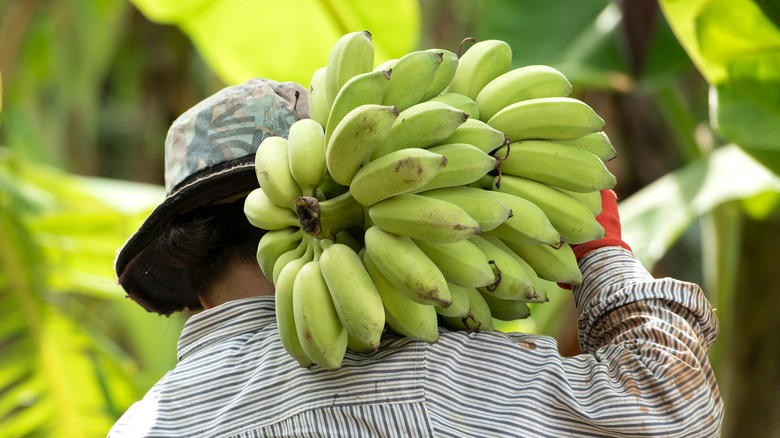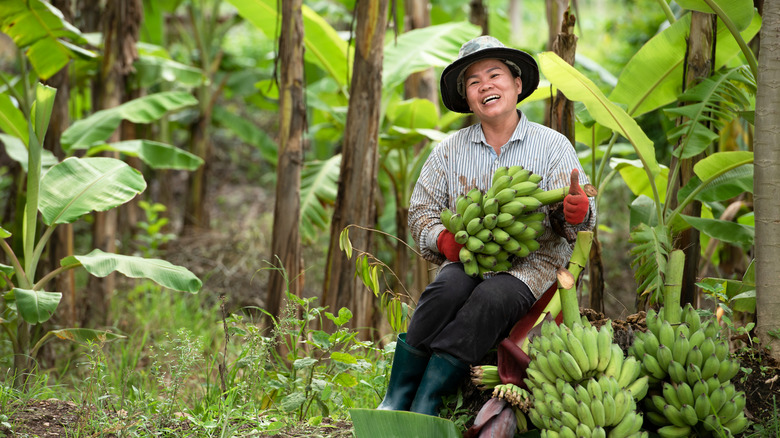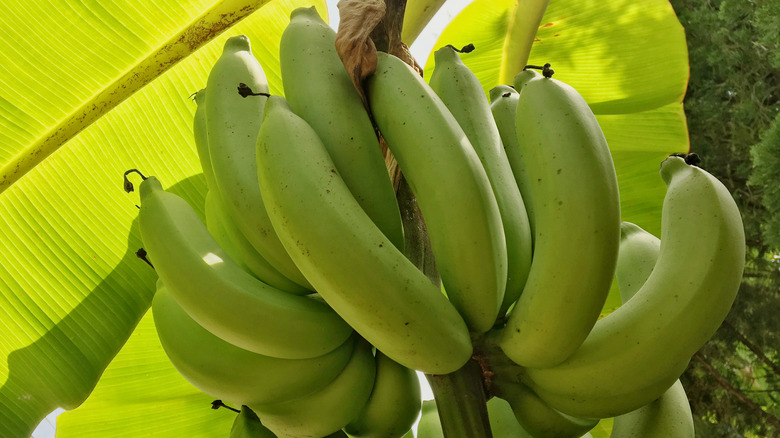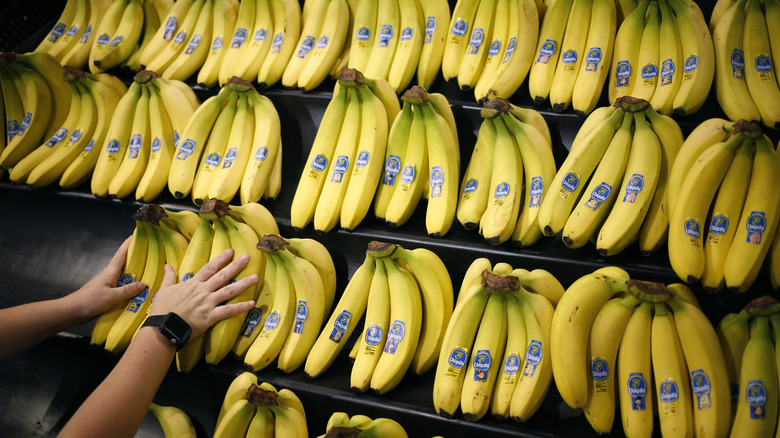The Reason Why Most Bananas May Go Extinct
Ask any 6 year old, and they'll tell you bananas are the world's most perfect food, and they're right. Not only are bananas tasty, but they're also packed with nutrients, and they even come in their own packaging: the peel. What's not to like? The sad truth of the matter is though is that the banana, at least as we know it today, may not last much longer. This time it's not strictly human impact that's threatening one of the world's most popular fruits, although we certainly do play a part. Instead, the most popular kind of banana in the world is currently threatened by natural causes. Some scientists say it might be too late to save them, as Time reports.
Per The Spruce Eats, there's more than just one type of banana, although all kinds of bananas taste something similar, and all types of bananas grow on trees. What this means is that across the world, if you ask for a banana what you might receive is something quite different from what many American schoolchildren eat in their lunches. Bananas come in a variety of different shapes, colors, and sizes. There are cooking bananas, red bananas, Pisang Raja bananas, Lady Finger bananas, and apple bananas, naming only a few. It's the Cavendish banana, though, that most people recognize from their local grocery store. It's this type of banana that's currently under threat of extinction.
It isn't the first time
According to Atlas Obscura, there was once another highly popular banana called the Gros Michel, sometimes called "Big Michael," or just "Big Mikes." Up until the early middle part of the 20th century, Gros Michel bananas were the most common banana variety. Today, their flavor is the stuff of legend, talked about on online banana fan message boards — because there are such things as online banana fan message boards and forums, apparently. Although Gros Michel bananas once ruled the market, the problem is, they're now virtually extinct, per Produce Blue Book. Crucially, what brought down the Big Michael is very similar to what now might make the popular Cavendish a thing of the past.
It was Fusarium wilt, also known as Panama disease that knocked Gros Michel off its pedestal, according to Produce Blue Book. Per Britannica, Fusarium wilt is a fungal disease and in the 1950s, an outbreak nearly killed off the Big Mike. Today, Gros Michel's can still be found in Uganda, although they're called something different: a Bogoya (via Product Blue Book). They're also grown in other areas of the world, such as Cuba, Myanmar, Malaysia, and Hawaii, as Atlas Obscura reports. In the broader global banana market, though, Gros Michel's are only available in high-end restaurants, from specialty markets, or direct from a farmer.
Big Mikes were a monoculture
What partially made the Gros Michel (pictured above) variety of bananas so susceptible to the '50s-era Panama disease outbreak is that they were monocultures. Per Merriam-Webster, a monoculture is a single species of plant, fruit, or vegetable grown repeatedly on a single plot of land with otherwise very little genetic diversity. According to Greentumble, this can leave certain plants, fruits, and vegetables like the "Big Mike" particularly susceptible to certain types of pests and diseases like Fusarium wilt. Monoculture soil also tends to be highly depleted from nutrients, further weakening the plant's defenses, according to Greentumble.
Making matters worse for the Gros Michel, fungus, bacteria, or whatever the disease is in question will concentrate wherever planets are particularly vulnerable. Per Newsweek, most bananas today are sterile and propagated through cloning, which only worsens their genetic diversity, putting the banana at further risk of being wiped out from an outbreak. This is exactly what's happened to the popular Cavendish banana, which is also a monoculture. All that being said, Cavendish bananas are in fact resistant to the Fusarium wilt Race 1 strains, contributing to this type of banana taking the limelight in markets all over the world. So what then has put the Cavendish on nature's shortlist for extinction?
Cavendish bananas are under attack
Although Cavendish bananas can handle the Fusarium wilt Race 1 strain that nearly wiped out the Big Mikes, this type of banana, accounting for almost half of all bananas grown worldwide and almost all banana exports, does have its own weak spot: Pseudocercospora fijiensis, a type of fungal disease known as Black Sigatoka, according to Newsweek. Banana plants stricken with Black Sigatoka yield less fruit. What's worse, the fungus causing Black Sigatoka has become resistant to some fungicide, which was an imperfect solution from the start due to added cost of pruning and application and the environmental and health risks associated with the application.
Another challenge the Cavendish is facing is a new strain of Fusarium oxysporum, currently ravaging crops in Southeast Asia. If the new Fusarium oxysporum makes it Central of South America, then Cavendish banana crops could be in real trouble. So what's to be done?
Genetic research is currently underway to strengthen the genetic diversity of commercial bananas by sequencing the genome of a large number of wild banana varieties, which are still plentiful, although this could lead to reduced yield, more seeds, and less shelf life for bananas in the supermarket, per Newsweek. With scores of wild banana varieties still existing in nature, it's unlikely the banana will go away permanently, but in the very near future, the kinds of bananas we take for granted in preschool lunches and at supermarkets may look and taste very different indeed.



